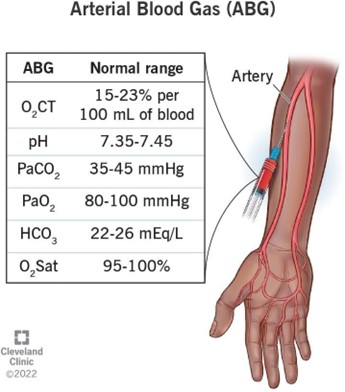A nurse is performing care for several clients with the help of an assistive personnel (AP). Which task should the nurse ask the AP to perform first?
Give fresh water to each client who does not have NPO status.
Obtain a routine urine sample from a client right after admission.
Transport a client to the radiology department for an x-ray.
Take an ABG specimen to the laboratory.
The Correct Answer is D
The nurse should ask the AP to perform the task of taking an ABG (arterial blood gas) specimen to the laboratory first. This is because ABG specimens need to be analyzed promptly to ensure accurate results. Timely analysis of ABG specimens is important for making clinical decisions and providing appropriate care to the client.
Option A is incorrect because giving fresh water to clients who do not have NPO status is not as time-sensitive as taking an ABG specimen to the laboratory.
Option B is incorrect because obtaining a routine urine sample from a client right after admission is not as time-sensitive as taking an ABG specimen to the laboratory.
Option C is incorrect because transporting a client to the radiology department for an x-ray is not as time-sensitive as taking an ABG specimen to the laboratory.

Nursing Test Bank
Naxlex Comprehensive Predictor Exams
Related Questions
Correct Answer is A
Explanation
Assistive personnel (AP), also known as unlicensed assistive personnel (UAP), can perform tasks such as recording vital signs ¹. Collecting intake and output [a] is a task that can be delegated to an AP.
The other options are not tasks that should be delegated to an AP.
Evaluating pain relief after administering pain medication [b] involves assessing the effectiveness of a medical intervention, which is typically the responsibility of a licensed nurse.
Providing a central line dressing change [c] is a complex task that requires specialized knowledge and skills.
Selecting a menu for a low-sodium diet [d] involves dietary planning, which is typically the responsibility of a licensed nurse or a registered dietitian.
Correct Answer is A
Explanation
If an assistive personnel (AP) refuses to take a specimen to the laboratory, the nurse should first discuss the incident with the AP. This allows the nurse to understand the reasons for the refusal and to address any concerns or issues that may have led to the refusal.
Option B may be necessary at some point, but it should not be the first response.
Option C may also be necessary to ensure that the specimen is delivered to the laboratory in a timely manner, but it does not address the underlying issue.
Option D may also be necessary at some point, but it should not be the first response.
Whether you are a student looking to ace your exams or a practicing nurse seeking to enhance your expertise , our nursing education contents will empower you with the confidence and competence to make a difference in the lives of patients and become a respected leader in the healthcare field.
Visit Naxlex, invest in your future and unlock endless possibilities with our unparalleled nursing education contents today
Report Wrong Answer on the Current Question
Do you disagree with the answer? If yes, what is your expected answer? Explain.
Kindly be descriptive with the issue you are facing.
